Deck 17: RlC Circuits and Resonance
سؤال
سؤال
سؤال
سؤال
سؤال
سؤال
سؤال
سؤال
سؤال
سؤال
سؤال
سؤال
سؤال
سؤال
سؤال
سؤال
سؤال
سؤال
سؤال
سؤال
سؤال
سؤال
سؤال
سؤال
سؤال
سؤال
سؤال
سؤال
سؤال
سؤال
سؤال
سؤال
سؤال
سؤال
سؤال
سؤال
سؤال
سؤال
سؤال
سؤال
سؤال
سؤال
سؤال
سؤال
سؤال
سؤال
سؤال
سؤال
سؤال
سؤال
سؤال
سؤال
سؤال
سؤال
سؤال
سؤال
سؤال
سؤال
سؤال
سؤال
سؤال
سؤال
سؤال
سؤال
سؤال
سؤال
سؤال
سؤال
سؤال
سؤال
سؤال
سؤال
سؤال
سؤال
سؤال
سؤال
سؤال
سؤال
سؤال
سؤال

فتح الحزمة
قم بالتسجيل لفتح البطاقات في هذه المجموعة!
Unlock Deck
Unlock Deck
1/98
العب
ملء الشاشة (f)
Deck 17: RlC Circuits and Resonance
1
To correctly bias a BJT, reverse-bias the base-emitter junction and forward-bias the base-collector
junction.
junction.
False
2
Class C amplifiers are used primarily at radio frequencies.
True
3
An enhancement-type MOSFET can operate with a positive value of VGS.
True
4
A transistor can be used as an electronic switch.

فتح الحزمة
افتح القفل للوصول البطاقات البالغ عددها 98 في هذه المجموعة.
فتح الحزمة
k this deck
5
Voltage gain can be found by 


فتح الحزمة
افتح القفل للوصول البطاقات البالغ عددها 98 في هذه المجموعة.
فتح الحزمة
k this deck
6
A BJT has three elements: emitter, gate, and collector.

فتح الحزمة
افتح القفل للوصول البطاقات البالغ عددها 98 في هذه المجموعة.
فتح الحزمة
k this deck
7
The overall voltage gain of a multistage amplifier is the product of the individual stage gains.

فتح الحزمة
افتح القفل للوصول البطاقات البالغ عددها 98 في هذه المجموعة.
فتح الحزمة
k this deck
8
The voltage gain of several amplifiers in series is found by adding the individual stage voltage
gains.
gains.

فتح الحزمة
افتح القفل للوصول البطاقات البالغ عددها 98 في هذه المجموعة.
فتح الحزمة
k this deck
9
If a common-emitter amplifier measures the same voltage on the collector as VCC, the amplifier is
operating in saturation.
operating in saturation.

فتح الحزمة
افتح القفل للوصول البطاقات البالغ عددها 98 في هذه المجموعة.
فتح الحزمة
k this deck
10
A current gain of almost one is a characteristic of a common-base amplifier.

فتح الحزمة
افتح القفل للوصول البطاقات البالغ عددها 98 في هذه المجموعة.
فتح الحزمة
k this deck
11
A depletion-type MOSFET can operate with a positive or negative value of VGS.

فتح الحزمة
افتح القفل للوصول البطاقات البالغ عددها 98 في هذه المجموعة.
فتح الحزمة
k this deck
12
The two types of BJTs are the PNP and the P-channel.

فتح الحزمة
افتح القفل للوصول البطاقات البالغ عددها 98 في هذه المجموعة.
فتح الحزمة
k this deck
13
The general characteristics of a common-emitter amplifier are high voltage gain, high current gain
and no phase reversal between the input and output voltages.
and no phase reversal between the input and output voltages.

فتح الحزمة
افتح القفل للوصول البطاقات البالغ عددها 98 في هذه المجموعة.
فتح الحزمة
k this deck
14
The gate current in a JFET is normally zero.

فتح الحزمة
افتح القفل للوصول البطاقات البالغ عددها 98 في هذه المجموعة.
فتح الحزمة
k this deck
15
A common-collector amplifier has a high input impedance compared to a common-emitter 18)
amplifier.
amplifier.

فتح الحزمة
افتح القفل للوصول البطاقات البالغ عددها 98 في هذه المجموعة.
فتح الحزمة
k this deck
16
The two types of BJTs are the NPN and PNP.

فتح الحزمة
افتح القفل للوصول البطاقات البالغ عددها 98 في هذه المجموعة.
فتح الحزمة
k this deck
17
An amplifier that provides its own input is called an oscillator.

فتح الحزمة
افتح القفل للوصول البطاقات البالغ عددها 98 في هذه المجموعة.
فتح الحزمة
k this deck
18
Two types of FETs are the JFET and the MOSFET.

فتح الحزمة
افتح القفل للوصول البطاقات البالغ عددها 98 في هذه المجموعة.
فتح الحزمة
k this deck
19
The general characteristics of a common-emitter amplifier are low voltage gain, low current gain
and very high power gain.
and very high power gain.

فتح الحزمة
افتح القفل للوصول البطاقات البالغ عددها 98 في هذه المجموعة.
فتح الحزمة
k this deck
20
An N-channel JFET has three elements: source, gate, and drain.

فتح الحزمة
افتح القفل للوصول البطاقات البالغ عددها 98 في هذه المجموعة.
فتح الحزمة
k this deck
21
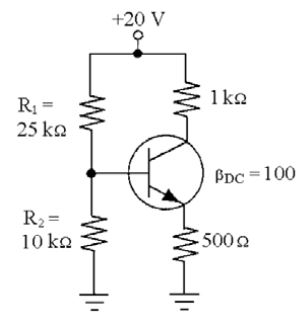
If
 equals 15 V in Figure 17-1, VBE equals ________.
equals 15 V in Figure 17-1, VBE equals ________.A)15 V
B)0.7 V
C)5 V
D)4.71 V

فتح الحزمة
افتح القفل للوصول البطاقات البالغ عددها 98 في هذه المجموعة.
فتح الحزمة
k this deck
22
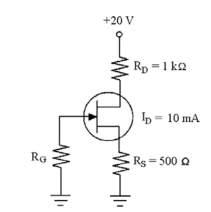
The amplifier in circuit Figure 17-2 uses a ________ and
 equals ________.
equals ________.A)BJT, 10 V
B)TRIAC, 5 V
C)JFET, 10 V
D)JFET, 0 V

فتح الحزمة
افتح القفل للوصول البطاقات البالغ عددها 98 في هذه المجموعة.
فتح الحزمة
k this deck
23

Find
 in Figure 17-1.
in Figure 17-1.A)11.4 V
B)16.4 V
C)7.10 V
D)6.4 V

فتح الحزمة
افتح القفل للوصول البطاقات البالغ عددها 98 في هذه المجموعة.
فتح الحزمة
k this deck
24

The device in Figure 17-2 is a ________.
A)NPN type BJT
B)P-channel MOSFET
C)N-channel JFET
D)depletion type MOSFET

فتح الحزمة
افتح القفل للوصول البطاقات البالغ عددها 98 في هذه المجموعة.
فتح الحزمة
k this deck
25

If the collector-to-emitter voltage is about 0 V in Figure 17-1, the possible trouble is ________.
A)the amplifier is saturated
B)the amplifier is cut off
C)this is a normal condition
D)the transistor is open

فتح الحزمة
افتح القفل للوصول البطاقات البالغ عددها 98 في هذه المجموعة.
فتح الحزمة
k this deck
26

If
 equals
equals  in Figure 17-1, the ________.
in Figure 17-1, the ________.A)transistor is cutoff
B)emitter has opened
C)power is off
D)emitter is shorted to the collector

فتح الحزمة
افتح القفل للوصول البطاقات البالغ عددها 98 في هذه المجموعة.
فتح الحزمة
k this deck
27

Find
 in Figure 17-2.
in Figure 17-2.A)-5 V
B)10 V
C)5 V
D)-10 V

فتح الحزمة
افتح القفل للوصول البطاقات البالغ عددها 98 في هذه المجموعة.
فتح الحزمة
k this deck
28

If
 opens in Figure 17-1, IC ________.
opens in Figure 17-1, IC ________.A)remains the same
B)decreases
C)increases
D)decreases to zero

فتح الحزمة
افتح القفل للوصول البطاقات البالغ عددها 98 في هذه المجموعة.
فتح الحزمة
k this deck
29

In all FETs, the drain current equals the ________ current.
A)emitter
B)collector
C)source
D)gate

فتح الحزمة
افتح القفل للوصول البطاقات البالغ عددها 98 في هذه المجموعة.
فتح الحزمة
k this deck
30

If
 opens in Figure 17-1,
opens in Figure 17-1,  equals ________.
equals ________.A)20 V
B)0.7 V
C)0 V
D)10 V

فتح الحزمة
افتح القفل للوصول البطاقات البالغ عددها 98 في هذه المجموعة.
فتح الحزمة
k this deck
31

If the emitter resistor opened in Figure 17-1,
 equals ________.
equals ________.A)20 V
B)5.71 V
C)0.7 V
D)0 V

فتح الحزمة
افتح القفل للوصول البطاقات البالغ عددها 98 في هذه المجموعة.
فتح الحزمة
k this deck
32

If the base-emitter junction opened in Figure 17-1,
 equals ________.
equals ________.A)20 V
B)0 V
C)10 V
D)5 V

فتح الحزمة
افتح القفل للوصول البطاقات البالغ عددها 98 في هذه المجموعة.
فتح الحزمة
k this deck
33

If
 mA in Figure 17-2,
mA in Figure 17-2,  equals ________.
equals ________.A)0 V
B)5 V
C)15 V
D)10 V

فتح الحزمة
افتح القفل للوصول البطاقات البالغ عددها 98 في هذه المجموعة.
فتح الحزمة
k this deck
34

The amplifier in Figure 17-2 uses a ________ and the gate current is ________.
A)TRIAC, 10 mA
B)JFET, 5 mA
C)JFET, 0 A
D)BJT, 0 A

فتح الحزمة
افتح القفل للوصول البطاقات البالغ عددها 98 في هذه المجموعة.
فتح الحزمة
k this deck
35

Find
 in Figure 17-2.
in Figure 17-2.A)5 V
B)15 V
C)10 V
D)0 V

فتح الحزمة
افتح القفل للوصول البطاقات البالغ عددها 98 في هذه المجموعة.
فتح الحزمة
k this deck
36

If
 mA in Figure 17-2,
mA in Figure 17-2,  equals ________.
equals ________.A)15 V
B)25 V
C)0 V
D)-7.5 V

فتح الحزمة
افتح القفل للوصول البطاقات البالغ عددها 98 في هذه المجموعة.
فتح الحزمة
k this deck
37

If the BJTʹs collector opened internally in Figure 17-1,
 equals ________.
equals ________.A)VBE
B)10 V
C)0 V
D)20 V

فتح الحزمة
افتح القفل للوصول البطاقات البالغ عددها 98 في هذه المجموعة.
فتح الحزمة
k this deck
38

Find
 in Figure 17-1.
in Figure 17-1.A)0.7 V
B)5.71 V
C)5 V
D)15 V

فتح الحزمة
افتح القفل للوصول البطاقات البالغ عددها 98 في هذه المجموعة.
فتح الحزمة
k this deck
39

Which voltage might indicate that the amplifier in Figure 17-1 is cut off?
A)

B)

C)

D)


فتح الحزمة
افتح القفل للوصول البطاقات البالغ عددها 98 في هذه المجموعة.
فتح الحزمة
k this deck
40

If

A)The amplifier is saturated.
B)The amplifier is cut off.
C)The power is off.
D)This is normal.

فتح الحزمة
افتح القفل للوصول البطاقات البالغ عددها 98 في هذه المجموعة.
فتح الحزمة
k this deck
41
The Class B amplifier conducts for ________ of the input cycle.
A)a small portion
B)180°
C)only 10°
D)360°
A)a small portion
B)180°
C)only 10°
D)360°

فتح الحزمة
افتح القفل للوصول البطاقات البالغ عددها 98 في هذه المجموعة.
فتح الحزمة
k this deck
42
What is the total voltage gain of a three-stage amplifier that has stage gains of 22, 112, and 8?
A)19,712
B)142
C)1,420
D)197,120
A)19,712
B)142
C)1,420
D)197,120

فتح الحزمة
افتح القفل للوصول البطاقات البالغ عددها 98 في هذه المجموعة.
فتح الحزمة
k this deck
43
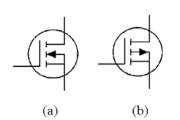
If a transistorʹs beta equals 30 and
 equals 1 mA,
equals 1 mA,  equals ________.
equals ________.A)1 mA
B)30 mA
C)0.33 mA
D)unknown

فتح الحزمة
افتح القفل للوصول البطاقات البالغ عددها 98 في هذه المجموعة.
فتح الحزمة
k this deck
44
Which one of these characteristics is found in a common-collector amplifier?
A)a high input resistance
B)a very high power gain
C)a current gain of one
D)a low input resistance
A)a high input resistance
B)a very high power gain
C)a current gain of one
D)a low input resistance

فتح الحزمة
افتح القفل للوصول البطاقات البالغ عددها 98 في هذه المجموعة.
فتح الحزمة
k this deck
45

For normal operation of a NPN transistor, the base must be ________.
A)positive with respect to the collector
B)positive with respect to the emitter
C)negative with respect to the emitter
D)disconnected

فتح الحزمة
افتح القفل للوصول البطاقات البالغ عددها 98 في هذه المجموعة.
فتح الحزمة
k this deck
46

To analyze the operation of a BJT in an amplifier circuit, use characteristic curves of:
A)base current versus collector to emitter voltage.
B)emitter current versus emitter to collector voltage.
C)collector current versus emitter to collector voltage.
D)collector current versus collector to emitter voltage.

فتح الحزمة
افتح القفل للوصول البطاقات البالغ عددها 98 في هذه المجموعة.
فتح الحزمة
k this deck
47
On transistor spec sheet, the key difference between 
A) represents
represents  represents
represents 
B) represents
represents  represents
represents 
C) represents
represents  represents
represents 
D) represents
represents  represents
represents 

A)
 represents
represents  represents
represents 
B)
 represents
represents  represents
represents 
C)
 represents
represents  represents
represents 
D)
 represents
represents  represents
represents 

فتح الحزمة
افتح القفل للوصول البطاقات البالغ عددها 98 في هذه المجموعة.
فتح الحزمة
k this deck
48
Although BJT transistors are current operated devices, a key characteristic is the signal voltage gain as an amplifier specified as:
A) .
.
B)
C)
D)
A)
 .
.B)

C)

D)


فتح الحزمة
افتح القفل للوصول البطاقات البالغ عددها 98 في هذه المجموعة.
فتح الحزمة
k this deck
49
To recognize transistor packages and identify the terminals, look for:
A)the flat side.
B)the imprinted dot.
C)the protruding tab.
D)all of these.
A)the flat side.
B)the imprinted dot.
C)the protruding tab.
D)all of these.

فتح الحزمة
افتح القفل للوصول البطاقات البالغ عددها 98 في هذه المجموعة.
فتح الحزمة
k this deck
50

The symbol in Figure 17-3(b) represents the ________.
A)N-channel depletion-type JFET
B)N-channel enhancement-type MOSFET
C)N-channel enhancement-type JFET
D)P-channel enhancement-type MOSFET

فتح الحزمة
افتح القفل للوصول البطاقات البالغ عددها 98 في هذه المجموعة.
فتح الحزمة
k this deck
51

The symbol in Figure 17-3(a) represents the ________.
A)N-channel enhancement-type JFET
B)N-channel enhancement-type MOSFET
C)P-channel enhancement-type MOSFET
D)N-channel depletion-type JFET

فتح الحزمة
افتح القفل للوصول البطاقات البالغ عددها 98 في هذه المجموعة.
فتح الحزمة
k this deck
52

If the base current increases, ________.
A)the collector current increases and the emitter current does not change
B)the collector current increases and the emitter current increases
C)the collector current increases and the emitter current decreases
D)the collector current decreases and the emitter current decreases

فتح الحزمة
افتح القفل للوصول البطاقات البالغ عددها 98 في هذه المجموعة.
فتح الحزمة
k this deck
53
In using BJT characteristic curves, the straight line drawn between the cutoff and the saturation points is called:
A)cutoff line.
B)load line.
C)saturation line.
D)operating line.
A)cutoff line.
B)load line.
C)saturation line.
D)operating line.

فتح الحزمة
افتح القفل للوصول البطاقات البالغ عددها 98 في هذه المجموعة.
فتح الحزمة
k this deck
54

Beta (β) is the ratio of ________.
A)collector current to base current
B)output voltage to input voltage
C)emitter current to base current
D)collector current to emitter current

فتح الحزمة
افتح القفل للوصول البطاقات البالغ عددها 98 في هذه المجموعة.
فتح الحزمة
k this deck
55

In all N-channel FETʹs, the current into the source equals the current leaving the ________.
A)source
B)drain
C)emitter
D)collector

فتح الحزمة
افتح القفل للوصول البطاقات البالغ عددها 98 في هذه المجموعة.
فتح الحزمة
k this deck
56

When a BJT amplifier is saturated,
 is about ________ and
is about ________ and  is ________.
is ________.A)zero, maximum
B)25 V, 10 mA
C)VCC, minimum
D)zero, minimum

فتح الحزمة
افتح القفل للوصول البطاقات البالغ عددها 98 في هذه المجموعة.
فتح الحزمة
k this deck
57

If a BJT amplifier is operated as a switch that is off, this operating condition is known as ________.
A)thermal runaway
B)VP
C)cutoff
D)saturation

فتح الحزمة
افتح القفل للوصول البطاقات البالغ عددها 98 في هذه المجموعة.
فتح الحزمة
k this deck
58

When a negative gate-to-source voltage is applied to an N-channel MOSFET, it operates ________.
A)in the enhancement mode
B)in the depletion mode
C)in the saturated state
D)in the cutoff state

فتح الحزمة
افتح القفل للوصول البطاقات البالغ عددها 98 في هذه المجموعة.
فتح الحزمة
k this deck
59
In using BJT characteristic curves, the intersection of the load line with a specific base current curve is called:
A)base point.
B)nudpoint.
C)Q point.
D)intersection point.
A)base point.
B)nudpoint.
C)Q point.
D)intersection point.

فتح الحزمة
افتح القفل للوصول البطاقات البالغ عددها 98 في هذه المجموعة.
فتح الحزمة
k this deck
60
What type of amplifier normally has a voltage gain of one?
A)common-mode
B)common-emitter
C)common-drain
D)common-source
A)common-mode
B)common-emitter
C)common-drain
D)common-source

فتح الحزمة
افتح القفل للوصول البطاقات البالغ عددها 98 في هذه المجموعة.
فتح الحزمة
k this deck
61
Which one of these amplifiers does NOT have the output in phase with the input?
A)common-drain
B)common-law
C)common-source
D)common-collector
A)common-drain
B)common-law
C)common-source
D)common-collector

فتح الحزمة
افتح القفل للوصول البطاقات البالغ عددها 98 في هذه المجموعة.
فتح الحزمة
k this deck
62
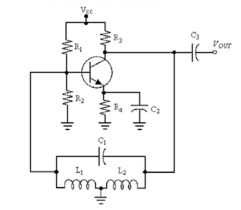
A Class ________ amplifier is very efficient.
A)C, audio
B)A, radio
C)C, radio
D)B, audio

فتح الحزمة
افتح القفل للوصول البطاقات البالغ عددها 98 في هذه المجموعة.
فتح الحزمة
k this deck
63
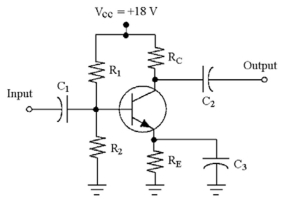
If the BJTʹs collector opens internally in Figure 17-4,
 ________.
________.A)drops almost to zero
B)increases
C)decreases
D)remains the same

فتح الحزمة
افتح القفل للوصول البطاقات البالغ عددها 98 في هذه المجموعة.
فتح الحزمة
k this deck
64

If the base-emitter junction opens in Figure 17-4, VC ________.
A)

B)

C)decreases to 0 volts
D)does not change

فتح الحزمة
افتح القفل للوصول البطاقات البالغ عددها 98 في هذه المجموعة.
فتح الحزمة
k this deck
65

If C1 opens in Figure 17-5, the circuit will probably ________.
A)increase its oscillating frequency
B)decrease its oscillating frequency
C)continue to operate normally
D)stop oscillating entirely

فتح الحزمة
افتح القفل للوصول البطاقات البالغ عددها 98 في هذه المجموعة.
فتح الحزمة
k this deck
66

If
 opens in Figure 17-4, VC equals ________.
opens in Figure 17-4, VC equals ________.A)9 V
B)18 V
C)VE
D)0 V

فتح الحزمة
افتح القفل للوصول البطاقات البالغ عددها 98 في هذه المجموعة.
فتح الحزمة
k this deck
67

If the collector opens in Figure 17-4, the output voltage ________.
A)decreases to zero
B)varies with temperature
C)increases
D)remains the same

فتح الحزمة
افتح القفل للوصول البطاقات البالغ عددها 98 في هذه المجموعة.
فتح الحزمة
k this deck
68

If RE opens in Figure 17-4,
 ________.
________.A)drops almost to zero
B)remains the same
C)increases
D)decreases

فتح الحزمة
افتح القفل للوصول البطاقات البالغ عددها 98 في هذه المجموعة.
فتح الحزمة
k this deck
69

Which voltage would indicate that the amplifier in Figure is operating in saturation?
A)

B)
 V
VC)
 V
V D)


فتح الحزمة
افتح القفل للوصول البطاقات البالغ عددها 98 في هذه المجموعة.
فتح الحزمة
k this deck
70

If the value of
 increases in Figure 17-5, the circuit ________.
increases in Figure 17-5, the circuit ________.A)operates at a higher frequency
B)operates at dc
C)operates at a lower frequency
D)does not change at all

فتح الحزمة
افتح القفل للوصول البطاقات البالغ عددها 98 في هذه المجموعة.
فتح الحزمة
k this deck
71

If the BJTʹs emitter internally shorted to its collector in Figure 17-4,
 ________.
________.A)decreases
B)remains the same
C)increases
D)drops almost to zero

فتح الحزمة
افتح القفل للوصول البطاقات البالغ عددها 98 في هذه المجموعة.
فتح الحزمة
k this deck
72

If C3 opens in Figure 17-4, ________.
A)the voltage gain decreases
B)the voltage gain increases
C)the dc emitter voltage decreases
D)the dc emitter voltage increases

فتح الحزمة
افتح القفل للوصول البطاقات البالغ عددها 98 في هذه المجموعة.
فتح الحزمة
k this deck
73

The circuit in Figure 17-5 is a ________ oscillator and uses ________ feedback.
A)Colpitts, positive
B)Colpitts, negative
C)crystal, negative
D)Hartley, positive

فتح الحزمة
افتح القفل للوصول البطاقات البالغ عددها 98 في هذه المجموعة.
فتح الحزمة
k this deck
74

The circuit in Figure 17-5 is known as a ________ oscillator because it has a ________ coil.
A)crystal, dual
B)Colpitts, dual
C)Hartley, dual

فتح الحزمة
افتح القفل للوصول البطاقات البالغ عددها 98 في هذه المجموعة.
فتح الحزمة
k this deck
75
Which one of these amplifiers has high input resistance and low output resistance?
A)common-cause
B)common-current
C)common-collector
D)common-emitter
A)common-cause
B)common-current
C)common-collector
D)common-emitter

فتح الحزمة
افتح القفل للوصول البطاقات البالغ عددها 98 في هذه المجموعة.
فتح الحزمة
k this deck
76

In Figure 17-5,
 form a ________ that provides ________ feedback to the amplifier.
form a ________ that provides ________ feedback to the amplifier.A)tank circuit, negative
B)tank circuit, out-of-phase
C)feedback network, negative
D)tank circuit, positive

فتح الحزمة
افتح القفل للوصول البطاقات البالغ عددها 98 في هذه المجموعة.
فتح الحزمة
k this deck
77

If R1 shorts in Figure 17-4,
 ________.
________.A)

B)

C)

D)does not change

فتح الحزمة
افتح القفل للوصول البطاقات البالغ عددها 98 في هذه المجموعة.
فتح الحزمة
k this deck
78

Which voltage would enable the circuit in Figure 17-4 to operate with little distortion?
A)

B)

C)

D)


فتح الحزمة
افتح القفل للوصول البطاقات البالغ عددها 98 في هذه المجموعة.
فتح الحزمة
k this deck
79

Which voltage might allow the circuit in Figure 17-4 to operate with minimum distortion?
A)

B)

C)

D)


فتح الحزمة
افتح القفل للوصول البطاقات البالغ عددها 98 في هذه المجموعة.
فتح الحزمة
k this deck
80
Crossover distortion occurs in a ________ amplifier when the amplifier is biased at ________.
A)push-pull, cutoff
B)common-emitter, saturation
C)push-pull, saturation
D)common-source, cutoff
A)push-pull, cutoff
B)common-emitter, saturation
C)push-pull, saturation
D)common-source, cutoff

فتح الحزمة
افتح القفل للوصول البطاقات البالغ عددها 98 في هذه المجموعة.
فتح الحزمة
k this deck








